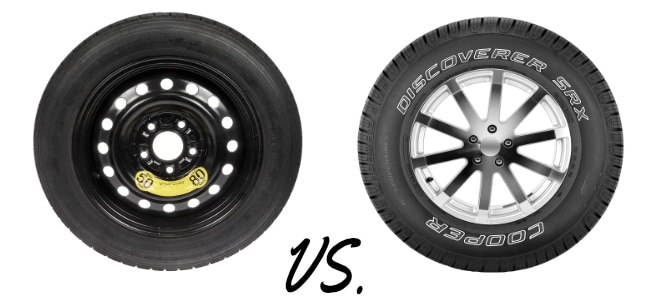How Long Can You Drive On A Spare Tire? [5 Must Know Q&A]
Many older cars have full-size spare tires, while new vehicles are increasingly moving to smaller spare tires, referred to as donut tires or space-saver tires. These tires take up less space and weigh less, assisting in improving fuel efficiency.
Drivers should include temporary spares as part of the regular maintenance routine and maintain proper air pressure in them. So, how long can you drive on a spare tire?
Manufacturers recommend that drivers, drive below the maximum speed of 50 miles per hour and avoid driving further than 70 miles to avoid damage to the transmission.
Cars with donut tires installed have poorer driving characteristics for braking, maneuvering, cornering, and overall control. They are designed to help get your vehicle to the nearest tire repair shop.
How many days can you drive on temporary spare tires?
Regular spare tires can be driven for as many days as you want, provided that they have the proper air pressure and they are balanced.
Donut tires should be limited to driving 70 miles distance. This can be over as many days as it takes to reach this distance. Since there is less traction and there is more wear on the transmission, drivers should have the regular tire repaired and reinstalled as soon as possible.
Run-flat tires should also be repaired as soon as possible. They are designed to run for 50 miles; however, these tires can be damaged further by driving on them in a run-flat mode. They are expensive to replace and should be repaired quickly.
Can you drive on the freeway with a spare tire?
Drivers can return to the freeway and operate their vehicles at normal speeds with regular spare tires as long as they are at the proper pressure.
Donut tires and run-flat tires with a puncture are not designed for normal freeway speeds. There is a loss of maneuverability at high speeds, less traction, and damage to the transmission could occur due to prolonged high-speed conditions.
Exit the freeway as soon as possible and have your regular tire repaired to avoid a second flat tire situation as well as driving too far on the donut or run-flat tires.
Can you drive 70 mph on a spare tire?
Drivers can drive at 70 mph on a regular size spare tire provided that it has the appropriate air pressure for your vehicle. If the spare has not been checked in some time, there is a possibility it is low on air pressure.
It is strongly recommended, not to drive above 50 mph with a donut or run-flat spare tire. These tires provide less traction and maneuverability, which declines even further at high speeds.
There is an additional strain on the transmission with one tire turning at normal speed, while the small donut tire turns faster.
Difference Between a Donut and Full-size Types of Tires

Donut tires are much smaller than regular full-size tires. They are designed to be used only in an emergency to get you to the nearest garage. With the smaller size, they rotate faster, provide less traction and less maneuverability.
Donut spare tires
Donut spare tires take up less space in the trunk, weigh less, and therefore, contribute to improved fuel efficiency.
They are smaller in size and are not recommended for speeds above 50 miles per hour or to be driven for distances longer than 70 miles to avoid potential accidents as well as damage to your transmission system.
Car owners should check all tires regularly, including the donut tire, for proper air pressure.
Full-size spare tires
Full-size spare tires are just like the regular tires on your vehicle. They weigh the same and take up more room in the trunk.
Car owners should check all of the tires for wear and tear, as well as air pressure once a month, including the spare tire. Some dealers recommend that the full-size spare tire should be included in the regular tire rotation for your vehicle to maintain even wear on all tires.
What is a run-flat tire?
More and more manufacturers are turning to run-flat tires. They are designed to withstand many road hazards, such as nail punctures.
Drivers can drive for approximately 50 miles, even after a puncture, which should be enough to get them to a repair center. While you do not need a spare tire, buying tires with a run-flat design cost more to replace, and they wear out just like normal tires.
What is a space-saver spare tire?
Space-saver tires are also referred to as donut spare tires. They are smaller, weigh less than regular tires, and save space, particularly in smaller cars where space is really at a premium.
These tires also improve gas mileage since they contribute to lower weights overall for vehicles. Space-saver spare tires have less traction and should not be driven faster than 50 mph or for a distance of 70 miles.
Should I get my tire repaired or replaced?

In most situations, the tire is repairable; however, there are conditions when it is not advisable to repair the tire. Your tire mechanic will provide recommendations regarding repair or replacement.
Replace the tire, if:
- The puncture is in the shoulder or sidewall
- More than one puncture, closer than 16 inches
- Large cuts or tread separation sustained due to a crash
- The tread is below safe driving standards.
Avoid emergency tire inflators and sealers. These fixes may be enough to get you to a dealer for repairs; however, they will not last long and do not perform well in cold weather.
Is my car’s braking or handling been affected if I used spare tires?
Even a full-size spare tire may impact braking and handling once installed. A combination of low air pressure and poor balancing can cause vibration, more difficulty cornering and maneuvering around obstacles.
Donut tires have a smaller wheel and tire, have less tread, and your car will dip somewhat. If it has low air pressure, these conditions are exaggerated. Controlling your vehicle, cornering, and maneuvering around obstacles will be more difficult, especially as speeds are increased.
Although run-flat tires are the same size as your other tires, the air pressure has decreased, making it difficult for run-flat tires to provide the same performance.
Always drive more slowly, under 50 mph, and avoid driving further than 70 miles to avoid damage to the tire, the rim, and the transmission.
Extra Tire Care Tips
Most of us forget about the spare tire until we need it. Over time all tires will lose air pressure, so when they are needed, even a full-size spare tire may not perform as well as the other tires on the car. Here are a few tire care tips to improve tire safety, every driver should consider for all of your tires:
- Confirm the tire pressure, including the spare, once a month
- Visually inspect the tires every day
- Check your spare tire once a month
- Check tire balance, including the spare, if you notice any vibration
- Rotate the tires following manufacturers guidelines in the vehicle owners manual
- Check the alignment once per year
Summary
Check your spare tire as part of your regular tire maintenance routine, including donut spare-tires. If you need to drive on the spare donut tire, keep your speed below 50 miles per hour and avoid driving more than 70 miles.
Have your punctured tires repaired or replaced immediately to avoid added issues? Remember, braking and maneuverability declines with a donut tire and tires with low pressure.
Car buying tips include purchasing a car with a full-size spare and cars with tires and wheels in good to excellent condition. Increase value for your trade by replacing older warn tires.
Last Updated on: March 16, 2025

